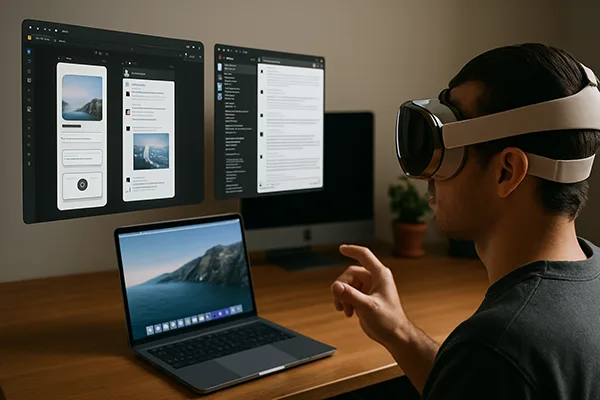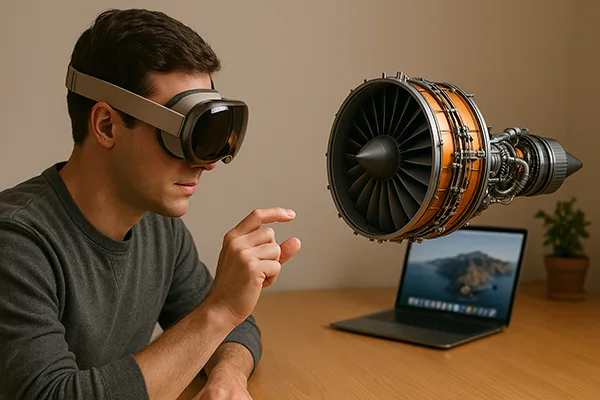How Apple Vision Pro Integrates into the Mac Ecosystem: First Impressions and Use Cases

In February 2025, Apple Vision Pro is no longer just an experimental piece of wearable tech—it’s becoming a central part of the Apple ecosystem. With its spatial computing capabilities, seamless integration with macOS, and a growing number of use cases across productivity and creativity, Vision Pro is redefining how users interact with their Macs. The headset blurs the line between physical and digital workspaces, introducing a new layer of interaction powered by visionOS.
Initial Compatibility with macOS and Device Pairing
From day one, Apple Vision Pro has demonstrated impressive compatibility with Mac devices. Users can wirelessly extend their Mac desktop into the spatial environment created by Vision Pro, making multitasking more immersive than ever. The headset mirrors or expands the Mac display via a secure Bluetooth connection, allowing users to interact with their regular macOS apps using hand gestures or eye-tracking input.
The setup process is remarkably smooth. As soon as Vision Pro is powered on and in proximity to a Mac, macOS Ventura or later recognises the device and offers connection options, similar to pairing with AirPods. Once linked, users can drag application windows directly into the Vision Pro space, offering up to 4K resolution per window in a virtual environment.
Importantly, no additional accessories are required. The integration uses existing Continuity and Handoff features to keep the experience fluid across devices. Files can be AirDropped from Mac to Vision Pro and vice versa, and Apple ID sign-in ensures synced settings and app permissions.
Performance and Multitasking in a Spatial Environment
In practice, working with Vision Pro alongside a Mac allows users to open multiple floating displays, each acting as a fully interactive macOS window. Designers can have their Figma canvas in one space, Slack on the left, and Safari on the right—all without physically switching monitors.
The performance is optimised through Apple Silicon. Macs with M1 chips or higher handle this extended environment seamlessly, with Vision Pro acting as a spatial external monitor. Latency is impressively low thanks to optimised rendering and the ultra-wide-band chip embedded in both devices.
Apple has also ensured that Vision Pro doesn’t drain the Mac’s performance. Most of the spatial computing tasks are processed within the headset itself, allowing the Mac to maintain its standard workload while powering advanced UI projection into the Vision Pro space.
Creative Applications and Collaboration Use Cases
Creative professionals are already exploring how Apple Vision Pro can transform their workflow. With support for Adobe Creative Cloud, Final Cut Pro, and Logic Pro, users can now manipulate timelines and canvases with a sense of depth and space that traditional displays lack.
In music production, Logic Pro spatial audio sessions gain a new dimension when visualised within Vision Pro. Producers can place tracks in 3D space, adjusting effects and levels with pinch or gaze gestures, leading to a more intuitive sound design experience. Final Cut users benefit from timeline extensions that flow in space, creating a unique editing layout that’s more aligned with natural movement.
Collaboration is also evolving. With SharePlay and FaceTime integrated directly into the headset, Vision Pro allows real-time co-editing or whiteboarding with colleagues. Using the headset’s eye tracking and facial expression recognition, meetings feel more engaging and human, even when conducted entirely virtually.
Educational and Enterprise Deployment Examples
Educational institutions have begun testing Vision Pro for hybrid learning environments. Professors can project lecture slides around the room, and students can annotate in 3D space. Medical schools, for example, use Vision Pro for immersive anatomy sessions, letting students virtually dissect human models with realistic spatial interaction.
In the enterprise sector, companies like Boeing and Deloitte are piloting Vision Pro for remote training and product development. Engineers wearing the headset can view technical schematics overlaid on physical components or walk through 3D models during design reviews. This significantly reduces the need for physical prototypes.
Corporate adoption is being driven by Apple’s partnerships with business software providers. Microsoft’s 365 Suite and Zoom have updated apps tailored for spatial computing, while industry-specific platforms in architecture and automotive engineering are rolling out beta support for Vision Pro integration.

Accessibility, Battery Life, and Real-World Feedback
Apple has prioritised accessibility with Vision Pro. Features like VoiceOver, Switch Control, and Voice Control are available within visionOS, ensuring users with various needs can benefit from its capabilities. The intuitive gesture control and eye-tracking system help reduce fatigue, particularly during long working sessions.
Battery life remains a practical concern. Vision Pro typically offers two hours of continuous use on a full charge, but with an optional tethered battery pack or USB-C passthrough to a Mac, the headset can function for an extended period. Apple is expected to improve battery efficiency with future software updates in mid-2025.
Early adopters note that comfort is satisfactory for short bursts of use, but extended sessions may require breaks. The lightweight materials help, but Apple is reportedly working on ergonomic accessories based on user feedback. Despite this, satisfaction rates are high among users integrating Vision Pro into their daily Mac workflows.
Security, Privacy, and Ecosystem Expansion
Security has been deeply embedded into the Vision Pro and Mac ecosystem connection. All spatial sessions are encrypted, and personal data never leaves the device without user consent. App permissions remain consistent with those set on the Mac, reducing the risk of unintended data sharing.
Apple’s Vision Pro also inherits biometric security features from the broader ecosystem. With Optic ID—based on iris recognition—unlocking the headset and authorising purchases is seamless. Combined with Apple’s existing commitment to privacy, the device aligns with enterprise and personal security expectations.
As Apple continues to evolve its ecosystem, Vision Pro is expected to support more native applications and deeper integrations by the end of 2025. Developers are already working on extensions to AppleScript and Shortcuts, aiming to give users more automation capabilities between macOS and visionOS environments.
